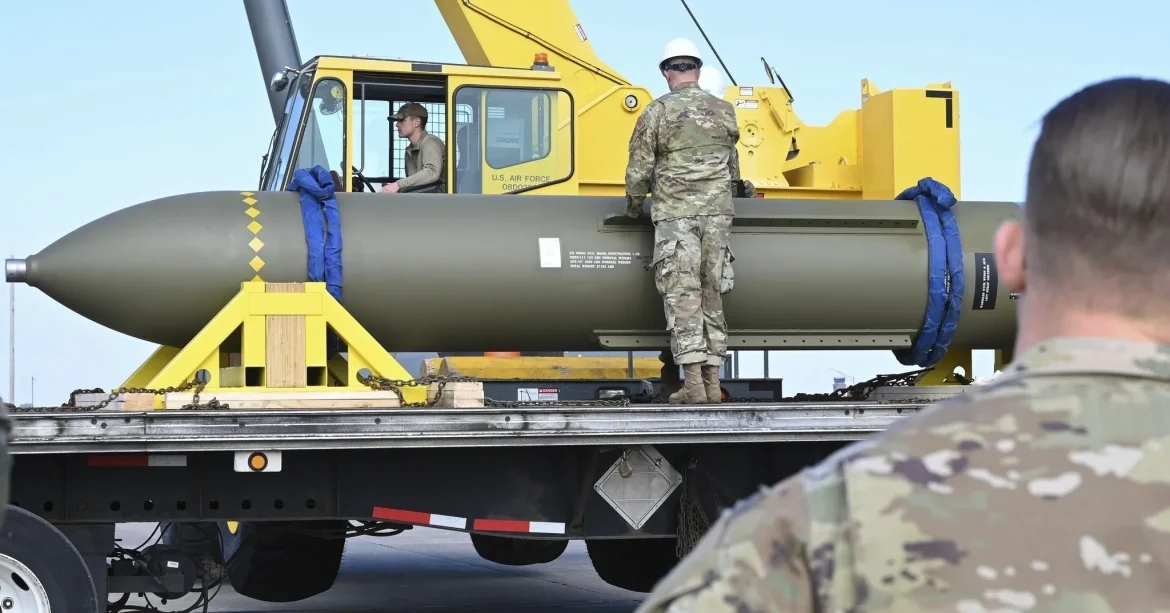Trump Signals Potential Shift in U.S. Policy Toward Israel-Iran Conflict
Amid escalating hostilities between Israel and Iran, U.S. President Donald Trump has indicated a possible move toward more direct support for Israel. The gesture, which could include supplying advanced bunker-buster bombs, has intensified concerns about the potential impact on Iran’s nuclear infrastructure and regional stability.
What Are Bunker-Buster Bombs and Why Are They Critical?
The GBU-57 A/B Massive Ordnance Penetrator, commonly referred to as a bunker-buster bomb, is a 13,600-kilogram, precision-guided munition developed by the United States to penetrate hardened underground facilities. Designed to breach up to 200 feet of earth and concrete before detonating, it presents a significant threat to facilities like Iran’s Fordow nuclear enrichment site—a heavily fortified installation buried deep underground.
According to the U.S. Air Force, these bombs can be used in succession to drill progressively deeper, increasing the likelihood of reaching underground targets like the centrifuge halls being used by Iran to enrich uranium. Though the bomb carries a conventional warhead, international watchdogs warn that its use on nuclear sites poses significant nuclear contamination risks.
Fordow Nuclear Facility in the Crosshairs
The Fordow facility, where Iran is known to be enriching uranium, is central to the tensions brewing in the region. The International Atomic Energy Agency (IAEA) has confirmed that Iran is producing highly enriched uranium at the Fordow site, raising red flags among global security experts. A strike involving a bunker-buster bomb could potentially breach the site, releasing radioactive materials into surrounding areas.
“The risk of nuclear material being released if a bunker-buster reaches Fordow is substantial,” an IAEA official stated, highlighting the environmental and humanitarian implications of possible military escalations.
Trump’s Strategic Calculations
In a recent press briefing aboard Air Force One, President Trump expressed his desire for a lasting solution to the Israel-Iran standoff. “We want to see a real end to this, not just another ceasefire,” he told reporters. Despite suggesting negotiations spearheaded by Vice President JD Vance and special envoy Steve Witkoff, Trump added he was “not too much in the mood to negotiate”—a tone that suggests a firmer stance could be imminent.
Trump had earlier criticized Iran for walking away from prior nuclear agreement offers. This rhetoric, paired with his openness to supplying more potent weaponry to Israel, signals a pivot from diplomacy to deterrence, or even confrontation.
Potential U.S. Military Involvement
Though President Trump has not committed U.S. forces to the conflict, ambiguity remains. In an interview with ABC News, he remarked, “It is possible we could get involved. But we are not at this moment involved.” Meanwhile, Vice President Vance echoed a similar tone on social media, stating, “The president has shown remarkable restraint… He may decide he needs to take further action to end Iranian enrichment.”
However, UK Prime Minister Keir Starmer indicated during the G7 Summit that there was no direct message from Trump suggesting an immediate military engagement. “There is nothing the president said that suggests he’s about to get involved in this conflict,” Starmer affirmed. “On the contrary, the G7 statement was about de-escalation.”
Israel’s Position on Fordow
Israeli Defence Minister Israel Katz has signaled that Iran’s Fordow facility is a target under consideration for military action. “Fordow is an issue that will be addressed,” Katz reportedly said, implying that preventive strikes against the nuclear site could soon be on the table.
The IAEA has also disclosed that previous Israeli strikes damaged Iran’s Natanz nuclear enrichment site, with contamination recorded inside but no known external leaks. These mentions further elevate speculation that Fordow might be the next critical target in the geopolitical chess game.
Implications for the Middle East
The introduction of GBU-57 bunker-busters into the conflict—should Trump follow through—may drastically alter the strategic equation. Only the U.S. Air Force’s B-2 Spirit stealth bomber is currently configured to deliver these bombs, and its ability to conduct long-range missions makes it a key player in any potential strike operation. With a range of 11,000 kilometers unrefueled and up to 18,500 kilometers with a single refueling, the B-2 can reach virtually any point around the globe within hours.
The potential use of such high-impact weapons has stirred concern among nuclear non-proliferation advocates and neighboring countries alike. A single misstep could trigger a broader regional conflict, or worse, a nuclear catastrophe.
Looking Ahead: Uncertain Diplomacy, Heightened Tensions
As the conflict between Israel and Iran continues, and with both sides trading fire frequently, the global community watches closely. Trump’s unpredictable policy shifts and suggestive military posturing keep regional stakeholders and international diplomats on edge. Meanwhile, the possible deployment of America’s most powerful non-nuclear bombs could make the current volatile situation far more dangerous.
What remains uncertain is whether Trump will push forward militarily or pivot back to negotiations. For now, the Fordow facility stands as both a strategic asset and a potential flashpoint in a conflict teetering on the edge of escalation.

